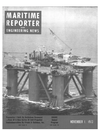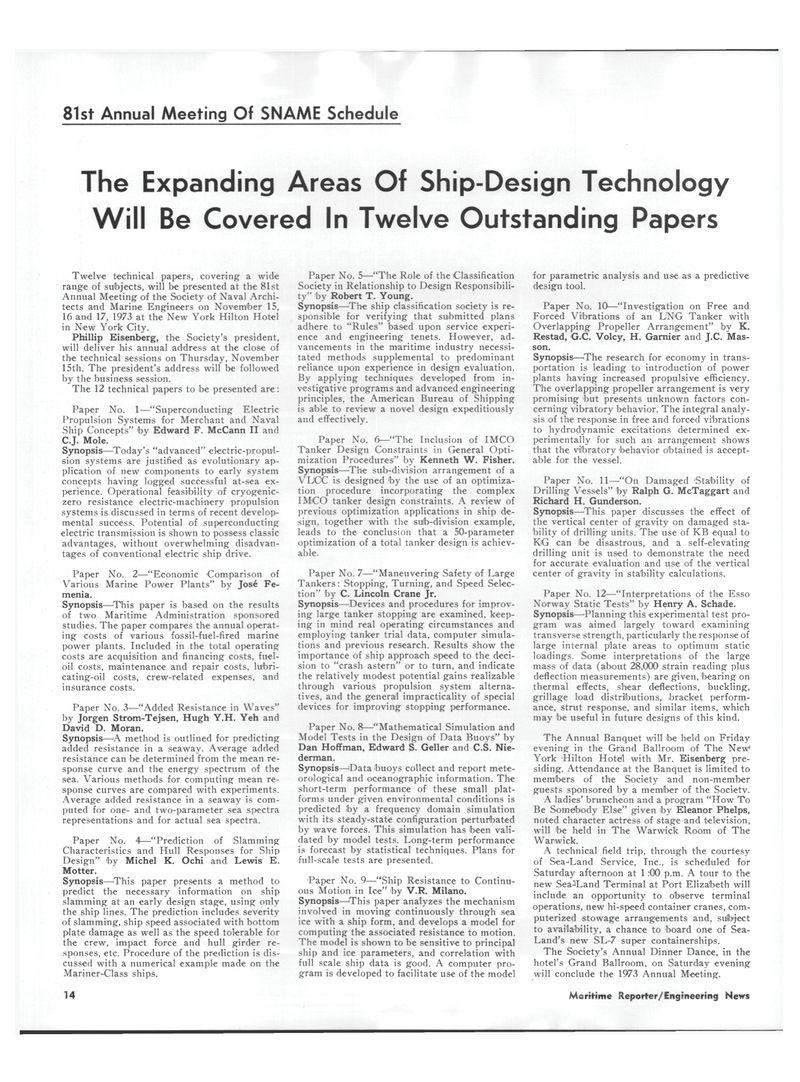
Page 12: of Maritime Reporter Magazine (November 1973)
Read this page in Pdf, Flash or Html5 edition of November 1973 Maritime Reporter Magazine
81st Annual Meeting Of SNAME Schedule
The Expanding Areas Of Ship-Design Technology
Will Be Covered In Twelve Outstanding Papers
Twelve technical papers, covering a wide range of subjects, will be presented at the 81st
Annual Meeting of the Society of Naval Archi- tects and Marine Engineers on November 15, 16 and 17, 1973 at the New York Hilton Hotel in New York City.
Phillip Eisenberg, the Society's president, will deliver his annual address at the close of the technical sessions on Thursday, November 15th. The president's address will be followed by the business session.
The 12 technical papers to be presented are:
Paper No. 1—"Superconducting Electric
Propulsion Systems for Merchant and Naval
Ship Concepts" by Edward F. McCann II and
C.J. Mole.
Synopsis—Today's "advanced" electric-propul- sion systems are justified as evolutionary ap- plication of new components to early system concepts having logged successful at-sea ex- perience. Operational feasibility of cryogenic- zero resistance electric-machinery propulsion systems is discussed in terms of recent develop- mental success. Potential of superconducting electric transmission is shown to possess classic advantages, without overwhelming disadvan- tages of conventional electric ship drive.
Paper No. 2—"Economic Comparison of
Various Marine Power Plants" by Jose Fe- menia.
Synopsis—This paper is based on the results of two Maritime Administration sponsored studies. The paper compares the annual operat- ing costs of various fossil-fuel-fired marine power plants. Included in the total operating costs are acquisition and financing costs, fuel- oil costs, maintenance and repair costs, lu'bri- cating-oil costs, crew-related expenses, and insurance costs.
Paper No. 3—"Added Resistance in Waves" by Jorgen Strom-Tejsen, Hugh Y.H. Yeh and
David D. Moran.
Synopsis—A method is outlined for predicting added resistance in a seaway. Average added resistance can be determined from the mean re- sponse curve and the energy spectrum of the sea. Various methods for computing mean re- sponse curves are compared with experiments.
Average added resistance in a seaway is com- puted for one- and two-parameter sea spectra representations and for actual sea spectra.
Paper No. 4—"Prediction of Slamming
Characteristics and Hull Responses for Ship
Design" by Michel K. Ochi and Lewis E.
Motter.
Synopsis—This paper presents a method to predict the necessary information on ship slamming at an early design stage, using only the ship lines. The prediction includes severity of slamming, ship speed associated with bottom plate damage as well as the speed tolerable for the crew, impact force and hull girder re- sponses, etc. Procedure of the prediction is dis- cussed with a numerical example made on the
Mariner-Class ships.
Paper No. 5—"The Role of the Classification
Society in Relationship to Design Responsibili- ty" by Robert T. Young.
Synopsis—The ship classification society is re- sponsible for verifying that submitted plans adhere to "Rules" based upon service experi- ence and engineering tenets. However, ad- vancements in the maritime industry necessi- tated methods supplemental to predominant reliance upon experience in design evaluation.
By applying techniques developed from in- vestigative programs and advanced engineering principles, the American Bureau of Shipping is able to review a novel design expeditiously and effectively.
Paper No. 6—"The Inclusion of IMCO
Tanker Design Constraints in General Opti- mization Procedures" by Kenneth W. Fisher.
Synopsis—'The sub-division arrangement of a
VDOC is designed by the use of an optimiza- tion procedure incorporating the complex
IMCO tanker design constraints. A review of previous optimization applications in ship de- sign, together with the sulb-division example, leads to the conclusion that a 50-parameter optimization of a total tanker design is achiev- able.
Paper No. 7—"Maneuvering Safety of Large
Tankers: Stopping, Turning, and Speed Selec- tion" by C. Lincoln Crane Jr.
Synopsis—'Devices and procedures for improv- ing large tanker stopping are examined, keep- ing in mind real operating circumstances and employing tanker trial data, computer simula- tions and previous research. Results show the importance of ship approach speed to the deci- sion to "crash astern" or to turn, and indicate the relatively modest potential gains realizable through various propulsion system alterna- tives, and the general impracticality of special devices for improving stopping performance.
Paper No. 8—"Mathematical Simulation and
Model Tests in the Design of Data Buoys" by
Dan Hoffman, Edward S. Geller and C.S. Nie- derman.
Synopsis—Data fouoys collect and report mete- orological and oceanographic information. The short-term performance of these small plat- forms under given environmental conditions is predicted £>y a frequency domain simulation with its steady-state configuration perturbated by wave forces. This simulation has been vali- dated by model tests. Long-term performance is forecast by statistical techniques. Plans for full-scale tests are presented.
Paper No. 9—"Ship Resistance to Continu- ous Motion in Ice" fey V.R. Milano.
Synopsis—This paper analyzes the mechanism involved in moving continuously through sea ice with a ship form, and develops a model for computing the associated resistance to motion.
The model is shown to be sensitive to principal ship and ice parameters, and correlation with full scale ship data is good. A computer pro- gram is developed to facilitate use of the model for parametric analysis and use as a predictive design tool.
Paper No. 10—"Investigation on Free and
Forced Vibrations of an LNG Tanker with
Overlapping Propeller Arrangement" by K.
Restad, G.C. Volcy, H. Gamier and J.C. Mas- son.
Synopsis—The research for economy in trans- portation is leading to introduction of power plants having increased propulsive efficiency.
The overlapping propeller arrangement is very promising but presents unknown factors con- cerning vibratory behavior. The integral analy- sis of the response in free and forced vibrations to hydrodynamic excitations determined ex- perimentally for such an arrangement shows that the vibratory behavior obtained is accept- able for the vessel.
Paper No. 11—"On Damaged •Stability of
Drilling Vessels" by Ralph G. McTaggart and
Richard H. Gunderson.
Synopsis—This paper discusses the effect of the vertical center of gravity on damaged sta- bility of drilling units. The use of KB equal to
KG can !be disastrous, and a self-elevating drilling unit is used to demonstrate the need for accurate evaluation and use of the vertical center of gravity in stability calculations.
Paper No. 12—"Interpretations of the Esso
Norway Static Tests" by Henry A. Schade.
Synopsis—Planning this experimental test pro- gram was aimed largely toward examining transverse strength, particularly the response of large internal plate areas to optimum static loadings. Some interpretations of the large mass of data (about 28,000 strain reading plus deflection measurements) are given, bearing on thermal effects, shear deflections, buckling, grillage load distributions, bracket perform- ance, strut response, and similar items, which may be useful in future designs of this kind.
The Annual Banquet will be held on Friday evening in the Grand Ballroom of The New1
York Hilton Hotel with Mr. Eisenberg pre- siding. Attendance at the Banquet is limited to members of the Society and non-member guests sponsored by a member of the Society.
A ladies' bruncheon and a program "How To
Be Somebody Else" given by Eleanor Phelps, noted character actress of stage and television, will be held in The Warwick Room of The
Warwick.
A technical field trip, through the courtesy of Sea-Land Service, Inc., is scheduled for
Saturday afternoon at 1:00 p.m. A tour to the new SeaJLand Terminal at Port Elizabeth will include an opportunity to observe terminal operations, new hi-speed container cranes, com- puterized stowage arrangements and, subject to availability, a chance to board one of Sea-
Land's new SL-7 super containerships.
The Society's Annual Dinner Dance, in the hotel's Grand Ballroom, on Saturday evening will conclude the 1973 Annual Meeting. 14 Maritime Reporter/Engineering News

 11
11

 13
13
